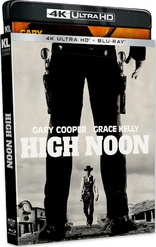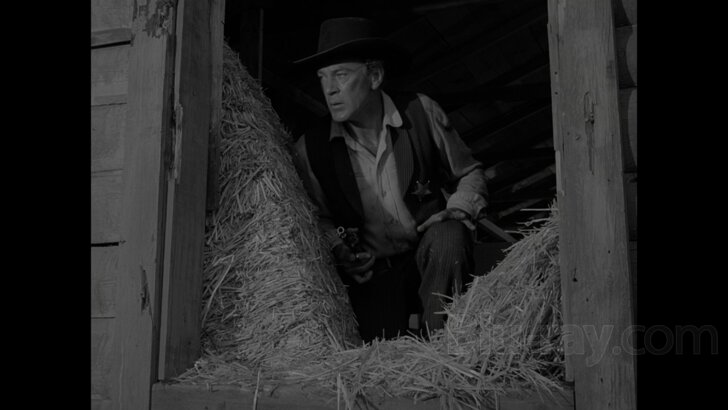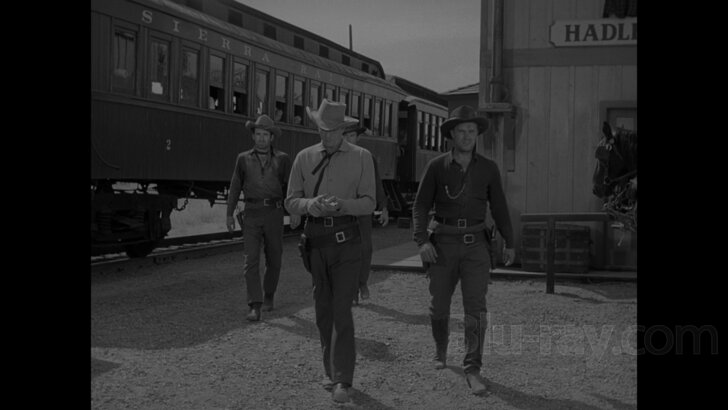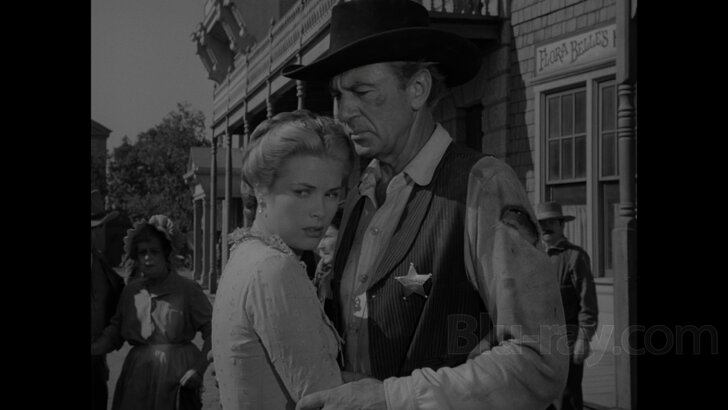High Noon 4K Blu-ray Movie
HomeHigh Noon 4K Blu-ray Movie 
4K Ultra HD + Blu-rayKino Lorber | 1952 | 85 min | Not rated | May 07, 2024

Movie rating
8.2 | / 10 |
Blu-ray rating
| Users | 3.8 | |
| Reviewer | 4.5 | |
| Overall | 3.8 |
Overview
High Noon 4K (1952)
A retired Marshal must defend his town from a revengeful villain.
Starring: Gary Cooper, Thomas Mitchell (I), Lloyd Bridges, Katy Jurado, Grace KellyDirector: Fred Zinnemann
| Drama | Uncertain |
| Western | Uncertain |
| Thriller | Uncertain |
Specifications
Video
Video codec: HEVC / H.265
Video resolution: 4K (2160p)
Aspect ratio: 1.33:1
Original aspect ratio: 1.37:1
Audio
English: DTS-HD Master Audio 2.0 Mono (48kHz, 24-bit)
Subtitles
English SDH
Discs
Blu-ray Disc
Two-disc set (2 BDs)
4K Ultra HD
Packaging
Slipcover in original pressing
Playback
Region A (locked)
Review
Rating summary
| Movie | 5.0 | |
| Video | 4.0 | |
| Audio | 5.0 | |
| Extras | 4.0 | |
| Overall | 4.5 |
High Noon 4K Blu-ray Movie Review
Reviewed by Dr. Svet Atanasov May 9, 2024Fred Zinnemann's "High Noon" (1952) arrives on 4K Blu-ray courtesy of Kino Lorber. The supplemental features on the release include archival program with editor Mark Goldblatt; archival program with filmmaker and film historian Michael Schlesinger; new audio commentaries by critics Alan K. Rode and Julie Kirgo; vintage trailer; and more. In English, with optional English SDH subtitles for the main feature. Region-Free.

Fred Zinnemann's western High Noon has been discussed so much during the years that at this point, there is nothing one can write about it that has not already been written by someone else. One can probably only add that its ‘classic’ status is certainly deserved.
Sheriff Will Kaine (Gary Cooper) has found the perfect woman (Grace Kelly) to settle down with and is now ready to retire. She has asked him to do so, and he has given her his word that as soon as they are pronounced husband and wife, he will take off his badge and call it quits.
But on his final day on the job, Kaine is told that his replacement will be late and that the notorious gunslinger Frank Miller (Ian MacDonald) is coming back to town. This is bad news for Kaine because a few years ago, when he cleaned up the town, he placed Miller behind bars, and he vowed to put a bullet in his head.
Miller is due to arrive on the noon train. He will be greeted by his three best men (one of them played by a very young-looking Lee Van Cleef), and then together they will go looking for Kaine.
The local residents urge Kaine to rush and leave town so that he can avoid confrontation with Miller, but he decides to stay and deal with the gunslinger once and for all. Shortly after, his wife abandons him, and then the town’s residents agree that it will be in their best interest to distance themselves and do the same.
The film has a very simple message: It is worth fighting and even dying for what is right. But during the years, there have been a number of very political interpretations of it that have been used to reframe it in different ways. One of these interpretations suggests that Miller portrayed the infamous Senator Joseph McCarthy and his gang as the HUAC (the House Un-American Activities Committee), while Kaine portrayed the film’s writer, Carl Foreman, who was a member of the Communist Party and was called before HUAC during the early 1950s. So the environment in which the clash between Kaine and Miller occurs apparently imitated the polarized and paranoid environment in which Foreman lived. There is another popular interpretation which suggests that the odd conflict between Kaine and the town’s residents reflected the division between people like Foreman and other communists who abandoned them and later on became informers and witnesses for McCarthy’s people. So in this interpretation, the focus of attention is actually on the erosion of trust between the communists as well as their bitter disillusionment.
It is also worth mentioning that during the Cold War era, the film resonated very differently with folks living behind the Iron Curtain. Kaine was seen as a promoter of the strength of American individualism, and his stance was interpreted as a veiled denunciation of the mass fear and hypocrisy that kept the communists and their lackeys in power for decades. So in this case, the film turned out to be quite effective as a pro-American piece with specific and surprisingly relevant political points.
Ultimately, however, the film’s strength isn’t in its ability to inspire political debates. Its technical qualities -- from the brilliant decision to shoot in real time to the careful framing choices to the great management of Dimitri Tiomkin’s score and the manner in which it enhances the tension and drama – are undeniably excellent.
The film is loosely based on John W. Cunningham's story "The Tin Star". According to various reports, however, producer Stanley Kramer bought the rights to the story after he discovered that Foreman’s script actually had plenty of similarities with the original story.
High Noon 4K Blu-ray Movie, Video Quality 

Kino Lorber's release of High Noon is a 4K Blu-ray/Blu-ray combo pack. The 4K Blu-ray is Region-Free. However, the Blu-ray is Region-A "locked".
Please note that some of the screencaptures that appear with this article are taken from the 4K Blu-ray and downscaled to 1080p. Therefore, they do not accurately reflect the quality of the 4K content on the 4K Blu-ray disc.
Screencaptures #1-19 are from the 4K Blu-ray.
Screencaptures #21-35 are from Blu-ray.
I have two other releases of High Noon in my library and used both to do various comparisons. The first is this Region-A release from Olive Films. The second is this Region-B release from Eureka Entertainment. Both releases introduced the same 4K restoration of the film, but in different territories.
On the 4K Blu-ray, High Noon can be viewed with Dolby Vision and HDR grades. I viewed the entire film with Dolby Vision and only quickly sampled a few areas with HDR. However, I spent plenty of time with the 1080p presentation, which I will address before the 4K native presentation.
On my system, the 1080p presentation clearly struggles to match the quality of the previous two releases I mentioned above. Why? In many areas, certain visuals look softer and flatter. The most obvious examples with such fluctuations emerge during outdoor footage, but some can be encountered even during indoor footage with sufficient light. It appears that high-frequency information is affected, creating the impression that a filter has been applied. On the previous releases, many of the same areas look sharper and better defined. Also, light black crushing is noticeable, and its presence exacerbates some of the softness and flatness. On my system, the best looking visuals were almost always close-ups.
In native 4K, virtually all of these inconsistencies are eliminated. I do not know exactly why. It could be that the superior encoding preserves more high-frequency information. It could be that the improved density levels and the expanded dynamic range of the visuals dramatically enhance the perception of depth. However, there is a pretty big difference in quality between the native 4K and 1080p presentations, and I do not think that it is justified. (The 1080p encode should have been a lot better, but I am unsure if this is the only reason there is such a substantial gap in quality. For the record, the framing discrepancy that exists between the previous releases and this release, 1.37:1 vs. 1.33:1, respectively, is irrelevant). Dolby Vision handles darker areas pretty well. However, some background information is easier to see on the previous releases. Fludity is very good, but a few uneven spots remain because of inherited source limitations.
So, what is the final verdict on the native 4K presentation? Its overall quality is very good. The dynamic range of many visuals is clearly improved. In many areas, depth appeared superior as well. The grayscale is convincing. But a few areas where high-frequency information could have been handled better and darker details should have been better exposed, slightly dampened my enthusiasm for the 4K presentation.
High Noon 4K Blu-ray Movie, Audio Quality 

There is only one standard audio track on this release: English DTS-HD Master Audio 2.0. Optional English SDH subtitles are provided for the main feature.
While viewing High Noon in native 4K, I did not encounter any technical anomalies to report in our review. The dialog is clear, sharp, and easy to follow. Of course, the native limitations of the original soundtrack are easy to recognize -- dynamic intensity is modest and some of Dimitri Tiomkin's music occasionally becomes a tad thin.
High Noon 4K Blu-ray Movie, Special Features and Extras 

4K BLU-RAY DISC
- Commentary One - this exclusive new audio commentary was recorded by author/film historian Alan K. Rode.
- Commentary Two - this exclusive new audio commentary was recorded by author/writer Julie Kirgo.
- Commentary One - this exclusive new audio commentary was recorded by author/film historian Alan K. Rode.
- Commentary Two - this exclusive new audio commentary was recorded by author/writer Julie Kirgo.
- A Ticking Clock - in this archival featurette, editor Mark Goldblatt (The Terminator) discusses the unique narrative structure of High Noon and its editing (with some excellent comments about the presence important role of clocks throughout the film). In English, not subtitled. (6 min).
- A Stanley Kramer Production - in this archival featurette, filmmaker and film historian Michael Schlesinger discusses Stanley Kramer's work as a producer and the socio-political environment at the time when he was most successful. In English, not subtitled. (14 min).
- Imitation of Life: The Blacklist History of High Noon - in this archival program, historian Larry Ceplair and blacklisted screenwriter Walter Bernstein discuss the production history of High Noon, Carl Foreman's blacklisting, and the McCarthy era. In English, not subtitled. (10 min).
- Oscars and Ulcers: The Production History of High Noon - this archival visual essay, narrated by Anton Yelchin, focuses on the production history of High Noon. Included with the essay are plenty of very rare and archival promotional materials. In English, not subtitled. (12 min).
- Uncitizened Kane - presented here is a text-format essay by Sight & Sound editor Nick James. (1080p).
- The Making of 'High Noon' (1992) - in this archival documentary, critic Leonard Maltin takes a closer look at High Noon and explains why it is one of the greatest westerns ever made. In English, not subtitled. (23 min).
- Trailer - original trailer for High Noon. In English, not subtitled. (2 min).
- Cover - reversible cover with vintage poster art for High Noon.
High Noon 4K Blu-ray Movie, Overall Score and Recommendation 

There have been some drastically different interpretations of the political overtones in Fred Zinnemann's High Noon, but I find them largely irrelevant now. The film is rightfully placed amongst the all-time greatest classics of the western genre because of its technical qualities, which are quite simply brilliant. Kino Lorber's release offers a good 4K presentation of High Noon on 4K Blu-ray, but if you purchased Olive Films' Blu-ray release a few years ago, you already have a very good looking copy of the film in your library. VERY HIGHLY RECOMMENDED.
Other editions
High Noon: Other Editions
Similar titles
Similar titles you might also like

The Man Who Shot Liberty Valance 4K
1962

Decision at Sundown 4K
1957

3:10 to Yuma
1957

Ride Lonesome
1959

My Darling Clementine
Theatrical and Prerelease Versions
1946

Unforgiven 4K
1992

Rio Bravo
1959

Winchester '73
1950

A Fistful of Dollars 4K
Per un Pugno di Dollari
1964

Once Upon a Time in the West 4K
Standard Edition | C'era una volta il West 4K
1968

Last Train from Gun Hill
Paramount Presents #18
1959

High Plains Drifter 4K
1973

Pat Garrett and Billy the Kid 4K
50th Anniversary Release (4K/BD), Original Theatrical Release (4K/BD), and Final Preview Cut (BD)
1973

One-Eyed Jacks
1961

Shane 4K
1953

The Proposition
2005

The Hired Hand
Arrow Academy
1971

The Searchers 4K
Warner Archive Collection
1956

Buchanan Rides Alone 4K
1958

The Magnificent Seven 4K
1960


